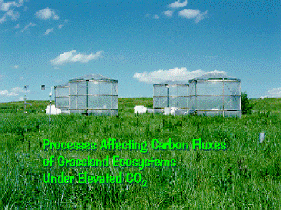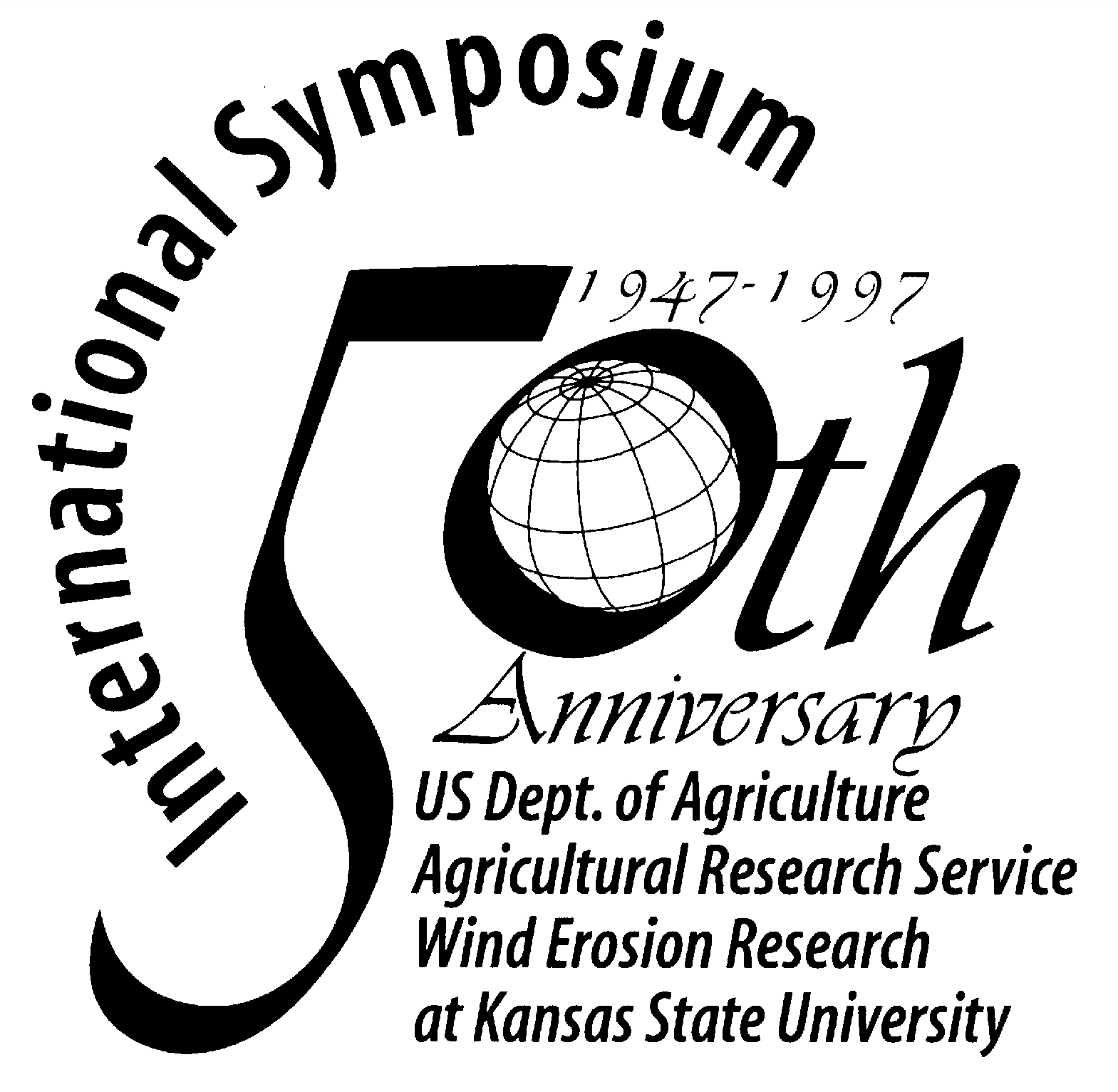|
 Processes Affecting
Carbon Fluxes of Grassland Ecosystems Under Elevated CO2
Processes Affecting
Carbon Fluxes of Grassland Ecosystems Under Elevated CO2
Clenton Ownnsby
Agronomy Department
Kansas State University
Manhattan, KS
USA
http://spuds.agron.ksu.edu/co2.htm
This project seeks to extend our knowledge of ecosystem-level carbon and water vapor
fluxes. A major goal of the proposed study is to determine the extent to which C4-dominated
grasslands will sequester carbon and act as a buffer against future increases in
atmospheric CO2 through a better understanding of the carbon and nitrogen
interactions with soil microbes. Our approach centers on water use efficiency changes
associated with elevated CO2. We continue to monitor above- and belowground
biomass production and monitor net carbon exchange and evapotranspiration at the chamber
level with natural precipitation in the original nine plots and by manipulating water
availability in four experimental chambers. Grazing impact cannot be assessed in the
current study, but, because of the importance of herbivory in natural systems, we will
determine the effect of elevated CO2 on regrowth biomass accumulation, water
relations, and physiology following top removal.
The experimental site for the tallgrass prairie research is located in pristine tallgrass
prairie north of and adjacent to the Kansas State University campus. Vegetation on the
site was a mixture of C3 and C4 species and was dominated by big
bluestem (Andropogon gerardii Vitman) and indiangrass [Sorghastrum nutans (L.) Nash].
Subdominants included Kentucky bluegrass (Poa pratensis L.), sideoats grama [Bouteloua
curtipendula (Michx.) Torr.], and tall dropseed [Sporobolus asper var. asper (Michx.)
Kunth]. Members of the sedge family made up 5-10% of the composition. Principal forbs
included ironweed [Vernonia baldwinii subsp. interior (Small) Faust], western ragweed
(Ambrosia psilostachya DC.), Louisiana sagewort (Artemesia ludoviciana Nutt.), and
manyflower scurfpea [Psoralea tenuiflora var. floribunda (Nutt.) Rydb.]. Average peak
biomass occurs in early August at 425 g m-2 of which 35 g m-2 is from forbs.
Soils in the area are transitional from Ustolls to Udolls (Tully series: fine, mixed,
mesic, montmorillonitic, Pachic Argiustolls). Slope on the area is 5%. Fire has been
infrequent, occurring two to three times in 10 years. Past history has included primarily
winter grazing by cow-calf pairs. The 30-year average annual precipitation is 84 cm, with
52 cm occurring during the growing season.
We continue fumigation with double ambient CO2 on the same plots that have
received that treatment for a 5-year period and compare those plots to ones with ambient
CO2, with and without a chamber. Use of these plots will be of particular
importance in assessing the long-term effects that elevated CO2 has on
ecosystem function and carbon storage in a grassland ecosystem. We have four additional
chambers which have been used to characterize canopy-level evapotranspiration and net
carbon exchange associated with CO2 enrichment and chamber effect at the plant
canopy level. We will manipulate water availability in those chambers to better
characterize biomass production and physiologic processes. Data collected in previous
studies as well as data collected in the ongoing study will be used in model development
and paramaterization to evaluate potential landscape and mesoscale impacts of elevated CO2
on carbon source/sink relationships and ET.
The fumigation chambers are a scaled-up version of a design described by Heagle et al.
(1979) as modified by the USDA-ARS Air Quality Field Laboratory at Raliegh, NC. The
chambers are 4.5 m in diameter by 3.25 m in height with a cone-top baffle that restricted
the top opening to 1.5 m. The baffle adds 0.75 m to the height of the open-top chamber for
a total height of 4 m. The cone-top baffle increases stability of the CO2
concentration and reduces CO2 required to maintain the desired concentration.
Chamber air is changed approximately two times per minute using a 91.4-cm dia, 6-bladed
fan powered by a 1.5 hp, 3-phase 220 v electric motor. Air delivery inside the chamber is
via a parabolic plenum consisting of a 75-cm dia polyethylene tube with 3.2-cm dia holes
on 18-cm centers on the inner half the tube. Chamber air flow rate is sensed using a
differential pressure transducer and the Bernoulli equation (Ham et al. 1993).
The structural framework is covered by 6 mil, UV-resistant polyethylene film. The
cone-top baffle placed atop each chamber reduces the opening to 1.5 m, thereby restricting
the precipitation that enters the chamber. A gutter system collects the precipitation into
a reservoir located on the ground where it is pumped to a sprinkler located in the center
of the chamber which is adjusted to cover the diameter of the chamber. Aluminum edging is
placed around the upslope bottom edge of the chamber to prevent run-off from entering the
chamber. On the four chambers with water availability manipulation, a barrier will be
placed to a depth of 1.5 m to eliminate water exchange from surrounding soil.
Control of CO2 concentration in open-top chambers is by computer-controlled
mass flow controllers. During each scan of the 15 plots CO2 concentration is
determined and for CO2-enriched plots the CO2 concentration for the
last ambient CO2 plot is doubled and compared with the current value for an
enriched chamber. If they are not equal, a new setpoint is calculated and sent to the mass
flow controller. Data are taken hourly for temperature, PAR, dewpoint temperature, and CO2
concentration. |




